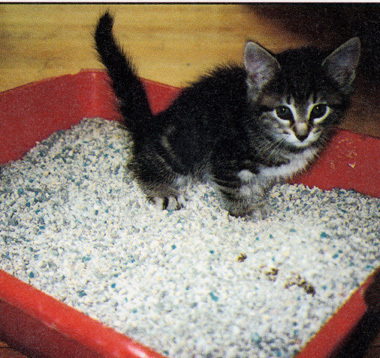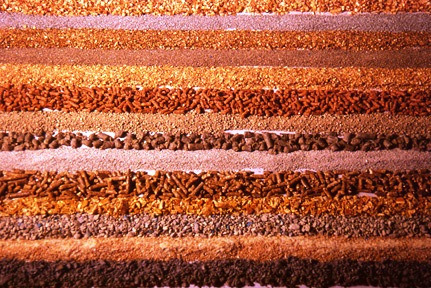
Kittens won’t care–so make your pick-of-the-litter early.
Cat litter choices can make or break a kitty-human relationship. What goes in your cat box? I’m not talking about Sheba’s “creative efforts” or the dog diving for those special kitty treats, but the substrate she likes to dig.
Did you know that indoor cat toilets are a relatively recent innovation? Most cats spent time outside and did their business in the dirt. The inside felines might be accommodated with a box of sand or perhaps ashes. Can you imagine the sooty footprints?
Litter-ary Hiss-tory
Back in the winter of 1947 in Cassopolis, Michigan, a cat owner’s sand pile froze, and she got tired of using ashes for her pet. She visited the local hardware that sold industrial absorbents including sawdust and filler’s earth (a type of clay). Edward Lowe suggested using clay instead of sand for the cat–and it turned into a multi-billion dollar industry after his introduction of the original Kitty Litter, and later Tidy Cats and Scamp. Purina bought the brands much later and expanded the market even further.
From humble beginnings at 65-cents per 5-pound bag, today cat owners find a smorgasbord of litter choices. But what you like and what Sheba prefers may not agree. We’re all about odor control and convenience. Cats just want something soft to dig in, that doesn’t offend their noses. Strong perfumes and dust can turn them off. And we all know what happens when Sheba shuns the box–we have to change the carpet!

There are 14 different kinds of litter–and I took that photo about 15 years ago, when writing a litter comparison article. Just imagine how many MORE kinds now!
You can still find plain clay litter. Cats love the clumping clay litters because of their fine texture. Humans love ‘em for their ease of scooping waste. But clay litters get dusty–they’re dirt, after all. The finer stuff tracks more, too, especially if it catches in very furry cat feet. The most common additive to make it clump, called sodium bentonite, can pose a risk to mouthy kittens that taste everything or to dogs intent on raiding the box.
To answer the demands of eco-friendly owners, you can find edible and biodegradable litters made from corn, wheat, paper, cedar chips, and even citrus. I’m a bit perplexed, frankly, by the citrus litters since most cats hate the smell and I recommend citrus as a feline deterrent. *shrug* Some of the corn and wheat products cats accept pretty well. Next week I’ve got a post about a new kind that Seren’s testing…so far, so good.
Bottom line–the best litter in the world ain’t worth spit if your kitten or cat won’t use it. Cats love routine, so if your cat’s happy with the facilities and tends to be persnickity, don’t mess with success. Unless you want new carpets.
What kinds of litter does your cat prefer? Would you rather use something else–environmentally conscious paper, perhaps? How do you reconcile the cat’s needs with your own $$ or other concerns? Do tell!
I love hearing from you, so please share comments and questions. Do you have an ASK AMY question you’d like answered–post in the comments. Do you have a new kitten and need answers? Stay up to date on all the latest just subscribe the blog, “like” me on Facebook, check out weekly FREE PUPPY CARE newsletter, and sign up for Pet Peeves newsletter. Stay up to date with the latest book give aways and appearances related to my THRILLERS WITH BITE!
 newest »
newest »
 newest »
newest »
 wheat and corn can attract weevils. Had to return some to the local pet store and advised them to throw it out. Maybe I should try paper... or not rock the litter box!
wheat and corn can attract weevils. Had to return some to the local pet store and advised them to throw it out. Maybe I should try paper... or not rock the litter box!
 Kim wrote: "wheat and corn can attract weevils. Had to return some to the local pet store and advised them to throw it out. Maybe I should try paper... or not rock the litter box!"
Kim wrote: "wheat and corn can attract weevils. Had to return some to the local pet store and advised them to throw it out. Maybe I should try paper... or not rock the litter box!"




